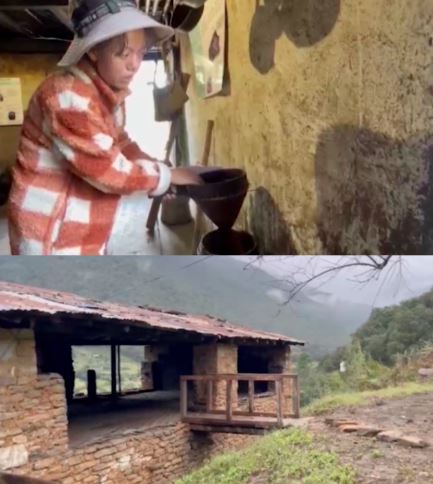Itanagar(Arunachal Pradesh): In an era when young women of her age go busy with cell phones and selfies, Leike Chomu, 24, from a far-off village bordering China, is up to something more serious and for posterity.
In a fast-changing world, where traditions are often forgotten, this young woman from the Monpa tribe is ensuring her community’s heritage lives on—not in books or behind glass, but within the very walls of her home.
Chomu has turned her 200-year-old ancestral house into a living museum. “More than just a collection of artefacts, the museum itself is a piece of history—built using ancient Monpa techniques with mud and stone. It talks about my humble effort to keep our cultural identity alive,” she says.
When WWF India officials approached her, they found her receptive as the effort to safeguard the unique heritage of the Monpa community got bolstered. However, the transformation of the house into a museum was something she took on personally.
From restoring the structure, conserving artefacts and setting up the space to make it accessible to visitors, Chomu has been actively involved in every step.
“Not just a project, it is my family’s legacy,” she adds.
With modernisation rapidly changing traditional lifestyles, she wanted to safeguard Monpa’s knowledge and everyday practices before they faded away.
“My idea was not to create a conventional museum with only artefacts. Through the initiative, I wanted to preserve the house itself, showcasing Monpa architecture, lifestyle, and traditions,” Chomu says.
According to her, visitors don’t just see historical objects, but can also experience how the Monpa people lived centuries ago.
After months of toil, the museum was formally launched on October 5 last year. Since then, many tourists and culture enthusiasts have visited.
“They are amazed that the museum isn’t just about objects but the house itself, its architecture, the way of life, and the stories it holds. Visitors appreciate the authenticity, often describing it as a rare and immersive experience that feels like stepping back in time,” Chomu added.
Some have even mentioned that walking through the house gives them a deep sense of connection to the Monpa heritage.
Originally from Chug Valley under Dirang in the West Kameng district of the northeastern state, Chomu holds a BSc degree in agriculture with a background in agroecology. Her deep connection to the land and traditional knowledge has fueled her passion for heritage preservation.
“The museum is my ancestral house. I have worked to preserve and transform it into a living museum,” she explains. “Coming from a family deeply tied to agriculture and local traditions, this project is especially meaningful to me. It’s not just about preserving history but about keeping our cultural identity alive for future generations,” she claims.
Restoring and maintaining a 200-year-old structure, while keeping it authentic, was not easy, she notes.
Preserving artefacts, convincing community elders of the importance of showcasing their heritage, and attracting tourists and researchers to sustain the museum in the long run are the hurdles, Chomu says.
“So far, there has been no financial support from the state government for this project. I hope that in the future, the government will recognise the importance of this heritage and provide assistance for its upkeep and expansion,” she says.
The initial funding and support came from WWF India, but beyond that, she has been managing the museum through personal efforts. “Since this museum is still a work in progress, there’s a lot more to be done, and I am continuously working on ways to improve and sustain it,” she said.
Chomu envisions transforming the museum into a cultural hub where visitors can actively engage with Monpa heritage rather than just observe it.
She plans to introduce storytelling sessions with community elders to share oral traditions, a small library featuring Monpa history and folklore, and eco-tourism initiatives such as a rest area near the museum where visitors can relax and experience traditional Monpa hospitality.
She also hopes to collaborate with local artisans and researchers to document and promote indigenous craftsmanship and traditions. Additionally, she aims to create employment opportunities for local women by involving them in museum activities such as handicrafts, storytelling, and hospitality services.
“My ultimate goal is to make the museum a self-sustaining heritage site, one that doesn’t just preserve Monpa culture but actively empowers the local community,” Chomu explained.
Through cultural tourism and traditional skill development, she wants to ensure that the Monpa heritage remains alive and benefits the people connected to it.
“Unlike conventional museums that display artefacts behind glass, this living museum preserves an entire way of life. Visitors don’t just see history; they experience it by stepping into a real Monpa household, where traditions are still alive,” she signs off.
Her effort got applause from Arunachal Pradesh Chief Minister Dorjee Khandu, who is also from the Monpa community. “Leike Chomu has transformed her 200-year-old ancestral home in Pangsa, Chug Valley, into a living museum to preserve Monpa culture. This initiative highlights the importance of traditional architecture and family bonding, showcasing utensils, wooden crockery, and more,” Khandu writes on X.
